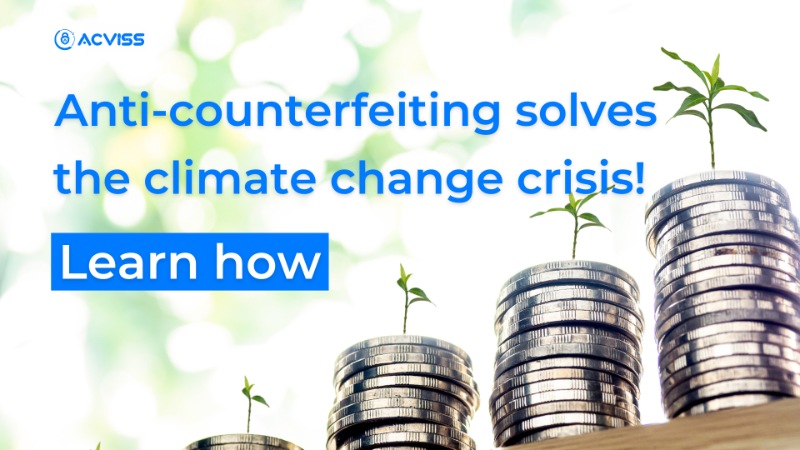Anti-counterfeiting solves the climate change crisis. Learn how.

Threat to our existence
Have you ever stopped to think about the impact that counterfeiting has on the environment? You might be surprised to learn that this illegal industry not only hurts the economy but also contributes to the already pressing issue of climate change.
How do counterfeit goods impact us?
Counterfeit goods are often manufactured in unregulated and uninspected facilities, using cheap materials and cutting corners on safety regulations. This results in toxic chemicals and waste being released into the environment, leading to a series of consequences such as:
Energy consumption: Counterfeit goods are often manufactured in countries with lower environmental standards and regulations, leading to increased energy consumption and greenhouse gas emissions. The transportation of counterfeit goods accounts for 2.5% of total global CO2 transportation emissions, which is equivalent to the emissions of the entire airline industry.
Increased Landfill Waste: According to the World Bank, counterfeit goods can account for up to 5% of global landfill waste. This waste not only takes up valuable space in landfills but also contributes to environmental degradation through the release of toxic chemicals and pollutants.
Increased Plastic Waste: Counterfeit goods often use cheap, low-quality plastics that are not biodegradable and can persist in the environment for hundreds of years. A study by the Ellen MacArthur Foundation found that by 2050, there will be more plastic in the ocean than fish if current trends continue.
E-waste: Counterfeit electronics, such as smartphones and laptops, often contain toxic chemicals that can leach into the environment and harm wildlife. And these products are often discarded after a short period of use, contributing to the growing problem of e-waste.
Hazardous Waste: Counterfeit goods, particularly those made from cheap materials, can pose a risk to public health and the environment. Dumping counterfeit medicines can be fatal to the soil and the water bodies nearby. Counterfeit toys and clothing may contain hazardous chemicals such as lead or phthalates that can harm children and wildlife
Resource depletion: The production of counterfeit goods often involves the use of precious resources, such as metals and minerals, that are becoming increasingly scarce. This contributes to resource depletion and exacerbates environmental problems such as deforestation, soil erosion, and pollution.
Deforestation: Counterfeiting often involves the use of illegal logging to obtain the raw materials needed for production. This contributes to deforestation and loss of habitat for wildlife, and can also lead to soil erosion, desertification, and other environmental problems.
Anti-counterfeiting is the solution!
But it's not all doom and gloom! Anti-counterfeiting solutions can definitely play a role in addressing the problem of climate change, but it's important to note that they are just one piece of the larger puzzle. While anti-counterfeiting measures can help reduce the environmental impact of counterfeit goods, they alone cannot solve the complex and global problem of climate change.

This can help to reduce the environmental impact of the production and distribution of these goods. By effectively addressing counterfeiting, we can reduce the environmental impact of goods and help to mitigate the effects of climate change.
Blockchain and Anti-Counterfeit Technology
One of the most effective ways to combat counterfeiting is through the use of blockchain combined with non-clonable anti-counterfeit technology. These technologies allow manufacturers and retailers to verify the authenticity of a product, track its journey from production to sale, and ensure that it is not a counterfeit. This not only helps to reduce the number of counterfeit goods in circulation, but it also makes it easier for consumers to make informed purchasing decisions and support sustainable products.
Joining hands
International cooperation and the sharing of information are great methods to combat counterfeiting. By working together, governments, law enforcement agencies, and industry organizations can identify and dismantle the networks responsible for producing and distributing counterfeit goods. This not only helps to reduce the production and distribution of these goods, but it also helps to hold those responsible accountable for their actions.
Sustainability
Anti-counterfeiting measures can help promote sustainable production and consumption. By reducing the demand for counterfeit goods, consumers are encouraged to purchase genuine, high-quality products that are made using environmentally-friendly materials and processes. This, in turn, can help to encourage manufacturers to adopt more sustainable practices, reducing the environmental impact of their products and contributing to a more sustainable future.
Transparency in the Supply chain
Anti-counterfeiting measures can help to increase the transparency of the supply chain and promote responsible sourcing. By ensuring that products are authentic, consumers can be confident that they are not supporting businesses that use child labour, engage in human rights abuses, or engage in other unethical practices. This can help to create a more sustainable and ethical marketplace and contribute to a more sustainable future.
It's up to you!
In short, Anti-counterfeiting solutions can be a major key in helping save the environment but consumers can also play a crucial role in the fight against counterfeits and climate change. By choosing to purchase only genuine products, consumers can help to reduce the demand for counterfeit goods and support sustainable and environmentally responsible production practices.
While counterfeiting is a complex issue, the fight against it can have a positive impact on the environment and help to address the pressing issue of climate change. By promoting anti-counterfeiting solutions and encouraging responsible consumption, we can create a more sustainable future for our planet.